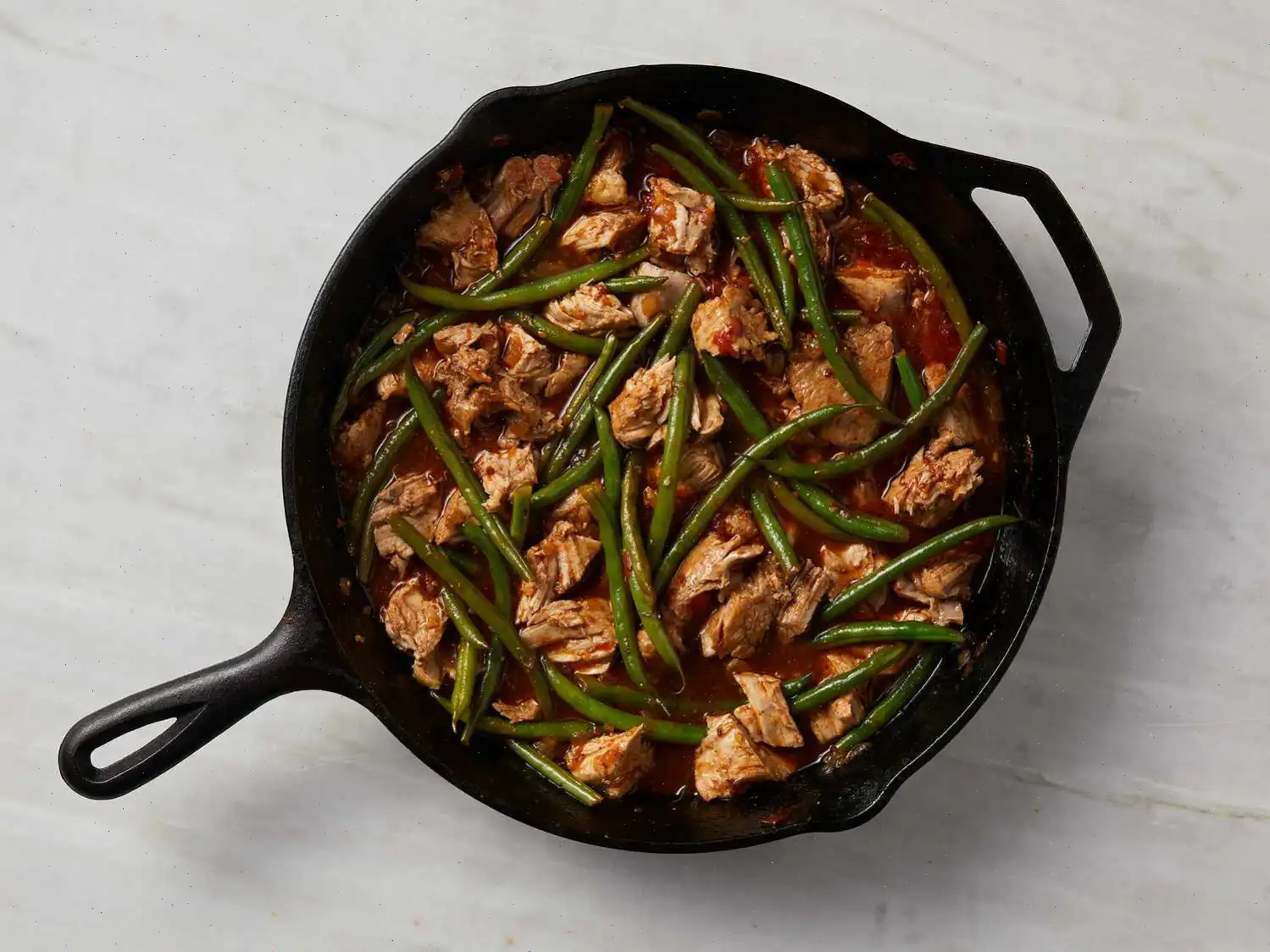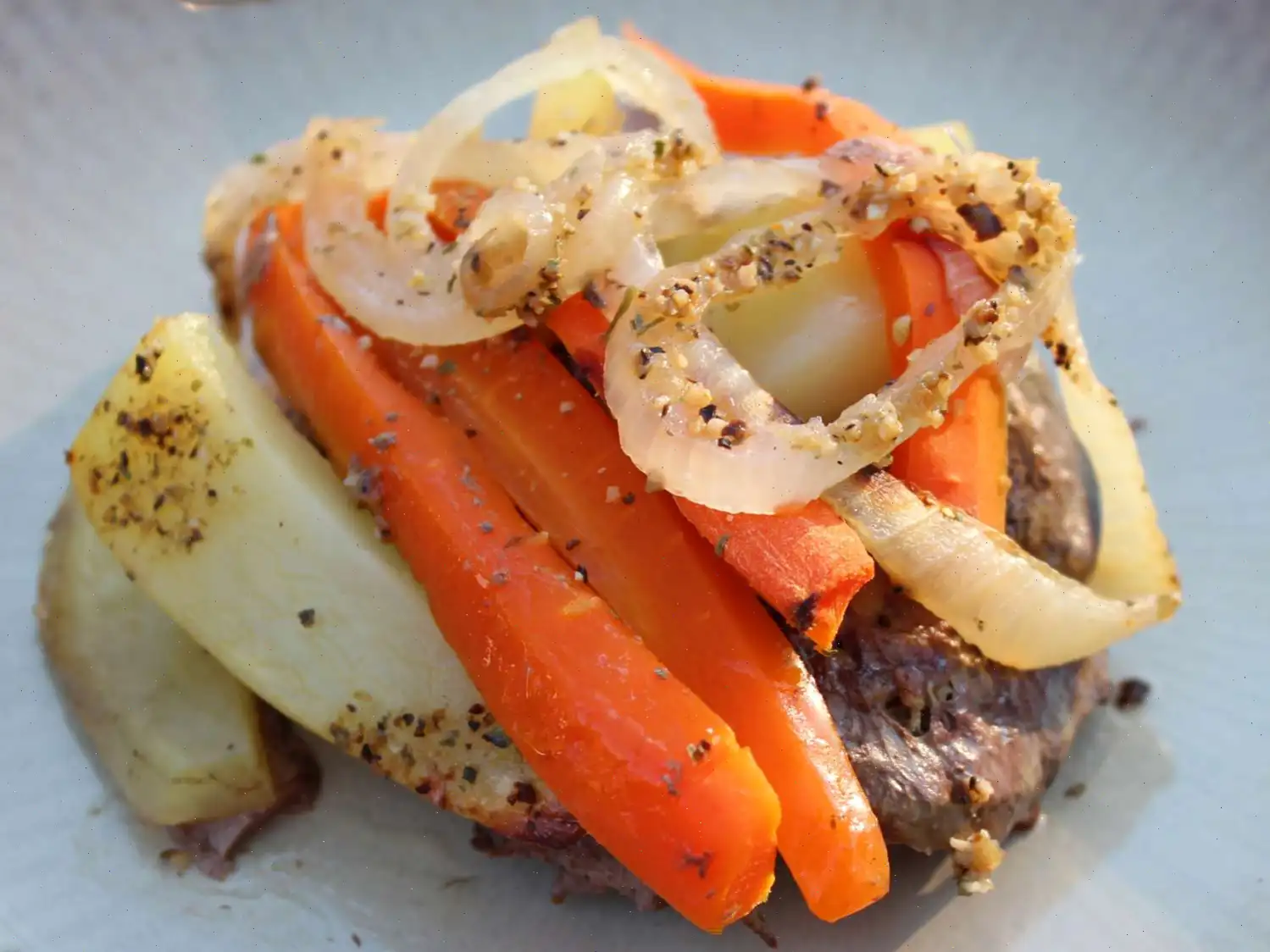
Pork Sinigang Recipe
Ingredients:
- 1 tablespoon vegetable oil
- 1 small onion, chopped
- 1 teaspoon salt
- 1 (1/2 inch) piece fresh ginger, chopped
- 2 plum tomatoes, cut into 1/2-inch dice
- 1 pound bone-in pork chops
- 4 cups water (more if needed)
- 1 (1.41 ounce) package tamarind soup base (such as Knorr)
- pound fresh green beans, trimmed
Directions:
- Heat vegetable oil in a skillet over medium heat.
- Add chopped onion to the skillet and cook, stirring frequently, until softened and translucent, about 5 minutes. Season with salt.
- Stir in chopped ginger and diced tomatoes, followed by the pork chops. Cover the skillet and reduce the heat to medium-low. Turn the pork chops occasionally until browned on all sides.
- Pour in water and add tamarind soup base. Bring the mixture to a boil, then reduce the heat and let it simmer. Cook until the pork chops are tender and fully cooked through, about 30 minutes.
- Add trimmed green beans to the skillet and cook until they are tender, about 5-7 minutes.
Nutrition Facts (per serving):
- Calories: 240
- Total Fat: 9g (12% DV)
- Saturated Fat: 2g (12% DV)
- Cholesterol: 64mg (21% DV)
- Sodium: 2598mg (113% DV)
- Total Carbohydrate: 12g (4% DV)
- Dietary Fiber: 3g (11% DV)
- Total Sugars: 3g
- Protein: 27g (53% DV)
- Vitamin C: 18mg (20% DV)
- Calcium: 66mg (5% DV)
- Iron: 2mg (8% DV)
- Potassium: 702mg (15% DV)
Percent Daily Values are based on a 2,000 calorie diet. Your daily values may be higher or lower depending on your calorie needs.

Sinigang is a beloved Filipino dish, renowned for its tangy, savory broth made from tamarind, ginger, and tomatoes. This variation made with pork is especially popular across the Philippines, offering a hearty and flavorful experience. Whether you are a Filipino food enthusiast or new to the cuisine, this comforting soup is a must-try.
History of Pork Sinigang
Sinigang, a Filipino soup with a distinct sour flavor, has a deep-rooted history in Filipino cuisine. Its origins can be traced back to pre-colonial times, when early Filipinos utilized native fruits like tamarind, guava, and bilimbi to add a tangy note to their stews. Though the dish has evolved over centuries, it remains a staple of Filipino comfort food. Pork Sinigang, in particular, is one of the most popular versions of this dish, likely due to the widespread availability of pork in the Philippines, which makes it an accessible and affordable choice for many families.
Regional Variations
Sinigang has regional variations, with each region adding its own touch to the dish. In the Visayas and Mindanao regions, for instance, people often use different types of souring agents such as guava or green mangoes, which offer a milder, sweeter tang compared to tamarind. In contrast, in the northern regions of Luzon, particularly in Metro Manila, the tamarind-based sinigang is the most common. Some regions also prefer using different cuts of pork, with options like pork belly, ribs, or neck bones being favored for their richness and tenderness when slow-cooked.
What Makes Pork Sinigang Different?
Although sinigang shares similarities with other sour soups in Southeast Asian cuisine, such as Thai Tom Yum or Indonesian Asam Pedas, the unique use of tamarind as the primary souring agent sets it apart. This gives Pork Sinigang its characteristic tartness, unlike the more herbal or citrus-based sourness found in other regional soups. Additionally, while many sour soups focus on the souring agent and a variety of herbs, Pork Sinigang is celebrated for its balance of sour, salty, and umami flavors, all coming together in a rich broth that is both complex and comforting.
Where is Pork Sinigang Usually Served?
Pork Sinigang is a quintessential family dish in the Philippines, often enjoyed as part of a hearty meal. It is typically served with steamed white rice and is commonly eaten for lunch or dinner. In Filipino households, it's a dish that brings families together, often enjoyed during special gatherings or even casual weeknight dinners. In restaurants, you may find sinigang on the menu as part of a typical Filipino feast, served alongside other dishes like adobo or lechon. It is especially popular on rainy days, as the warm and sour broth offers comfort and satisfaction.
Interesting Facts About Pork Sinigang
- Sinigang is often considered a "sour soup," but its complexity comes from the addition of other ingredients like tomatoes, onions, and various vegetables, giving it a balance of flavors.
- In the Philippines, many families grow their own tamarind trees, making it easy to source the key ingredient fresh for sinigang.
- Despite its status as a traditional Filipino dish, sinigang has seen many modern adaptations, with people incorporating different meats like shrimp, fish, or beef. Some even experiment with vegetarian versions, replacing meat with tofu or mushrooms for a plant-based option.
- Filipino restaurants outside of the Philippines often use instant tamarind soup mix for convenience, although using fresh tamarind is preferred for an authentic, robust flavor.
FAQ about Pork Sinigang Recipe
Comments
Daniel Davis
08/25/2024 06:03:09 PM
Thank you for sharing this recipe :)












